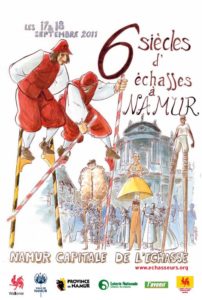DISCOVER
NAMUR STILT JOUSTING : EXPLANATIONS
The silt walkers of Namur perpetuate the practice of the Namur stilts jousts.
- the ‘Mélans’ (yellow and black stilts) representing the old city
- the ‘Avresses’ (red and white stilts) represinting the new city and the surroundings
During the fight, punctuated by the drums, the jousters try to bring down the opponents of the other company from their stilts using various methods.
The goal of the joust is simply to bring down all the opposing jousters. A stilt walker who has fallen cannot indeed get back on his stilts. Most often, the game ends when one of the two companies occupies the game area alone.
However, it can happen that the stilt walkers offer a “bout-a-tot” (“until the end”). In this case, the remaining jousters from the victorious brigade compete against each other to designate the individual winner. The “bout-a-tot” is offered to honor a distinguished visitor or to thank a particularly warm audience. It is also systematic during the great joust of the golden stilt.
THE NAMUR STILTS JOUST : A LIVING HERITAGE
Joust on stilts is a very lively practice which enjoys great affection among the people of Namur.
Mélans (yellow and black) and Avresses (red and white) still compete regularly today. Several jousts are organized during the year in Namur and in the region, mainly during popular festivals.
The most important takes place on the 3rd Sunday of September. On the occasion of the Festival of Wallonia, the great joust of the golden stilt takes place on Place St Aubain in front of more than 6,000 spectators. At the end of this highlight of Namur folklore, the winner receives the golden stilt and the unofficial title of best stilt jouster of the year.
Since 1937, the stilt jousters have also represented the city and the region on numerous occasions outside of Belgium.
Since 2015, young jousters aged 6 to 11 have been brought together in the “junior team” and are so introduced to jousting on smaller stilts.
In September 2022, the very first women’s joust in history took place.
600 YEARS OF NAMUR STILT JOUSTING HISTORY IN 12 DATES
Joust for Charles the Fifth
During the enthronement’s ceremonies of Charles V as Count of Namur, the future emperor watches a fight in his honour. He will see one again in 1530.
Joust for Philip II of Spain
Prince Philip, the future King of Spain, attends a stilt jousters’ fight in Namur. He is so satisfied with it that a second fight is offered to him two days later.
Anthology joust for the carnival
The 1669 carnival’s joust is so epic that it inspires the Count Wallef a "Heroic Poem" of more than 30 pages that he is going to publish in 1678.
Joust for the Sun King
After having taken the city and its citadel in 1692, Louis XIV is back in Namur one year later. On this occasion, the citizens of the city offered him a great stilt fight.
Joust given in front of the Tsar Peter the Great
In 1717, Peter the Great, Tsar of all Russias, is visiting Namur. The citizens of the city offers him a stilt fighters’ fight. The sources of that time announce us that the Tsar loved it: « His Majesty expressed so much joy and satisfaction from this fight that the people of his Court insured having never seen him in such a cheerful and satisfied mood for ten years. »
Joust for Napoleon
On Thermidor 15 of the year XI, Napoleon is in Namur with his wife Josephine. Two fights are given for them. The Avresses were victorious and received the prize from the First Consul personally.
Disastrous joust for Leopold I, king of the Belgians
In September 1849, the whole royal family is present in Namur to visit a provincial horticultural exhibition. She was welcomed at the Iron Gate by the two Stilt fighters’ teams. Unfortunately many breaks and very long speeches led our Stilt fighters to drink copiously. The fight given at the ’Place Saint-Aubain’ is ridiculed, the Stilt fighters staggering and clinging each other. The scandal is such that the City of Namur will confiscate the stilts one week later.
–
"ECHASSEUR", THE WORD THAT ONLY EXISTS IN THE REGION OF NAMUR
Ainfi ces echaffeurs foûtenant leur querelle,
Sembloient prendre en tombant une force nouvelle,
Et les voyant ainfi l'un lautre fe pouffer,
Le combat dirait-on ne fait que commencerBlaise-Henri de Corte, baron de Walef, 1669




